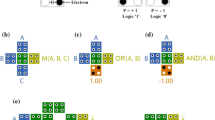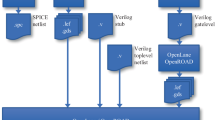Abstract
A new architecture for the synthesis of fault-tolerant digital devices, which is easier to implement as compared to the well-known architecture based on triple modular redundancy (TMR), is proposed. The architecture is implemented based on the Boolean complement principle, which implies the use of a special control block for evaluating complement functions, rather than by introducing exact copies of an original circuit. In practice, its complexity can be significantly lower than the complexity of the original circuit. This makes it possible to synthesize fault-tolerant devices with simpler designs as compared to TMR-based devices. The proposed architecture consists of three blocks: the original circuit, the signal error detection circuit, and the signal correction circuit. The synthesis of a fault-tolerant digital device is aimed at generating the structure of the signal error detection circuit, which implements the idea of duplication of complements. The advantages and disadvantages of the proposed fault-tolerant architecture are discussed. The results of experiments on some combinational benchmarks, which demonstrate the effectiveness of the proposed approach, are presented.




Similar content being viewed by others
REFERENCES
McCluskey, E.J., Logic Design Principles with Emphasis on Testable Semicustom Circuits, Englewood Cliffs, N.J.: Prentice-Hall, 1986.
Sogomonyan, E.S. and Slabakov, E.V., Samoproveryaemye ustroistva i otkazoustoichivye sistemy (Self-Testing Devices and Fault-Tolerant Systems), Moscow: Radio i Svyaz’, 1989.
Mikoni, S.V., Obshchie diagnosticheskie bazy znanii vychislitel’nykh sistem (General Diagnostic Knowledge Bases of Computing Systems), St. Petersburg: SPIIRAN, 1992.
Sapozhnikov, V.V., Sapozhnikov, Vl.V., Khristov, Kh.A., and Gavzov, D.V., Metody postroeniya bezopasnykh mikroelektronnykh sistem zheleznodorozhnoi avtomatiki (Methods for Constructing Safe Microelectronic Systems of Railway Automation), Sapozhnikov, V.V., Ed., Moscow: Transport, 1995.
Drozd, A.V., Kharchenko, V.S., Antoshchuk, S.G., Drozd, Yu.V., Drozd, M.A., and Sulima, Yu.Yu., Rabochee diagnostirovanie bezopasnykh informatsionno-upravlyayushchikh system (Operational Diagnostics of Safe Information Control Systems), Drozd, A.V. and Kharchenko, V.S., Eds., Kharkov: Nats. Aerokosmicheskii Univ. im. Zhukovskogo, 2012.
Kharchenko, V., Kondratenko, Yu., and Kacprzyk, J., Green IT Engineering: Concepts, Models, Complex Systems Architectures, Studies in Systems, Decision and Control, vol. 74, Cham: Springer, 2017. https://doi.org/10.1007/978-3-319-44162-7
Gavrilov, M.A., Ostianu, V.M., and Potekhin, A.I., Reliability of discrete systems, Itogi nauki i tekhniki. Seriya Teoriya veroyatnostei. Matematicheskaya statistika. Teoreticheskaya Kibernetika (Results of Science and Technology. Probability Theory. Mathematical Statistics. Theoretical Cybernetics), Moscow, 1969, pp. 7–104.
Lysenko, I.V. and Kharchenko, V.S., Potential vitality of multi-layered majorant-reserved systems subject to adverse impulse effects, Autom. Remote Control, 1997, vol. 58, no. 2, pp. 320–327.
Sklyar, V.V. and Kharchenko, V.S., Fault-tolerant computer-aided control systems with multiversion-threshold adaptation: Adaptation methods, reliability estimation, and choice of an architecture, Autom. Remote Control, 2002, vol. 63, no. 6, pp. 991–1003. https://doi.org/10.1023/A:1016130108770
Hamamatsu, M., Tsuchiya, T., and Kikuno, T., Finding the optimal configuration of a cascading TMR system, 14th IEEE Pacific Rim Int. Symp. on Dependable Computing, Taipei, 2008, IEEE, 2008, pp. 349–350. https://doi.org/10.1109/PRDC.2008.12
Matsumoto, K., Uehara, M., and Mori, H., Evaluating the fault tolerance of stateful TMR, 13th Int. Conf. on Network-Based Information Systems, Takayama, Japan, 2010, IEEE, 2010, pp. 332–336. https://doi.org/10.1109/NBiS.2010.86
Borecký, J., Kohlík, M., Vit, P., and Kubátová, H., Enhanced duplication method with TMR-like masking abilities, Euromicro Conf. on Digital System Design (DSD), Limassol, Cyprus, 2016, IEEE, 2016, pp. 690–693. https://doi.org/10.1109/DSD.2016.91
Krcma, M., Kotasek, Z., and Lojda, J., Triple modular redundancy used in field programmable neural networks, IEEE East-West Design & Test Symp. (EWDTS), Novi Sad, Serbia, 2017, IEEE, 2017, pp. 1–6. https://doi.org/10.1109/EWDTS.2017.8110128
Shcherbakov, N.S., Samokorrektiruyushchiesya diskretnye ustroistva (Self-Correction Discrete Devices), Moscow: Mashinostroenie, 1975.
Stempkovskiy, A.L., Telpukhov, D.V., Zhukova, T.D., Gurov, S.I., and Solovyev, R.A., Synthesis methods of fault-tolerant combination CMOS circuits providing automatic correction of errors, Izv. Yuzhnogo Fed. Univ. Tekh. Nauki, 2017, no. 7, pp. 197–210. https://doi.org/10.23683/2311-3103-2017-7-197-210
Sogomonyan E.S., Self-correction fault-tolerant systems, Preprint, 2018.
Sapozhnikov, V.V., Sapozhnikov, Vl.V., and Efanov, D.V., Osnovy teorii nadezhnosti i tekhnicheskoi diagnostiki (Foundations of the Reliability Theory and Engineering Diagnostics), St. Petersburg: Lan’, 2019.
Sapozhnikov, V.V., Sapozhnikov, Vl.V., and Efanov, D.V., Kody Khemminga v sistemakh funktsional’nogo kontrolya logicheskikh ustroistv (Hamming Codes in Systems of Functional Control of Logic Devices), St. Petersburg: Nauka, 2018.
Sapozhnikov, V.V., Sapozhnikov, Vl.V., and Efanov, D.V., Kody s summirovaniem dlya sistem tekhnicheskogo diagnostirovaniya (Codes with Summation for Systems of Engineering Diagnostics), Vol. 1: Klassicheskie kody Bergera i ikh modifikatsii (Classical Berger Codes and Their Modifications), Moscow: Nauka, 2020.
Sapozhnikov, V.V., Sapozhnikov, Vl.V., and Efanov, D.V., Kody s summirovaniem dlya sistem tekhnicheskogo diagnostirovaniya (Codes with Summation for Systems of Engineering Diagnostics), Vol. 2: Vzveshennye kody s summirovaniem (Weight-Based Codes with Summation), Moscow: Nauka, 2021.
Sapozhnikov, V.V., Sapozhnikov, Vl.V., Dmitriev, A.V., Morozov, A.V., and Gessel’, M., Organization of functional control of combinational circuits by the logical complement method, Elektron. Model., 2002, vol. 24, no. 6, pp. 52–66.
Gessel, M., Morozov, A.V., Sapozhnikov, V.V., and Sapozhnikov, Vl.V., Logic complement, a new method of checking the combinational circuits, Autom. Remote Control, 2003, vol. 64, pp. 153–161. https://doi.org/10.1023/A:1021884727370
Göessel, M., Ocheretny, V., Sogomonyan, E., and Marienfeld, D., New Methods of Concurrent Checking, Frontiers in Electronic Testing, vol. 42, Dordrecht: Springer, 2008. https://doi.org/10.1007/978-1-4020-8420-1
Pivovarov, D.V., Formation of concurrent error detection systems in multiple-output combinational circuits using the Boolean complement method based on constant-weight codes, Avtom. Transp., 2018, vol. 4, no. 1, pp. 131–149.
Sapozhnikov, V.V., Sapozhnikov, Vl.V., Efanov, D.V., and Pivovarov, D.V., Boolean complement method based on constant-weight code “1-out-of-4” for formation of totally self-checking concurrent error detection systems, Elektron. Model., 2017, vol. 39, no. 2, pp. 15–34.
Sapozhnikov, V.V., Sapozhnikov, Vl.V., and Efanov, D.V., Signal correction for combinational automation devices on the basis of Boolean complement with control of calculations by parity, Informatika, 2020, vol. 17, no. 2, pp. 71–85. https://doi.org/10.37661/1816-0301-2020-17-2-71-85
Efanov, D.V., Sapozhnikov, V.V., and Sapozhnikov, Vl.V., Typical structure of a duplicate error correction scheme with code control with summation of weighted transitions, Elektron. Model., 2020, vol. 42, no. 5, pp. 38–50. https://doi.org/10.15407/emodel.42.05.038
Efanov, D.V., Sapozhnikov, V.V., and Sapozhnikov, Vl.V., Boolean-complement based fault-tolerant electronic device architectures, Autom. Remote Control, 2021, vol. 82, no. 8, pp. 1403–1417. https://doi.org/10.1134/S0005117921080075
Ghosh, S., Basu, S., and Touba, N.A., Synthesis of low power CED circuits based on parity codes, 23rd IEEE VLSI Test Symp. (VTS’05), Palm Springs, Calif., 2005, IEEE, 2005, pp. 315–320. https://doi.org/10.1109/VTS.2005.80
Zakrevskij, A., Pottosin, Yu., and Cheremisinova, L., Optimization in Boolean Space, Tallinn: TUT Press, 2009.
Kunz, W. and Menon, P.R., Multi-level logic optimization by implication analysis, IEEE/ACM Int. Conf. on Computer-Aided Design, San Jose, Calif., 2002, IEEE, 2002, pp. 6–13. https://doi.org/10.1109/ICCAD.1994.629735
Sentovich, E.M., Singh, K.J., Moon, C., Savoj, H., Brayton, R.K., and Sangiovanni-Vincentelli, A., Sequential Circuit Design Using Synthesis and Optimization, Proc. 1992 IEEE Int. Conf. on Computer Design: VLSI in Computers & Processors, Cambridge, Mass., 2002, IEEE, 2002, pp. 328–333. https://doi.org/10.1109/ICCD.1992.276282
Collection of digital design benchmarks. http://ddd.fit.cvut.cz/www/prj/Benchmarks/. Cited April 13, 2021.
Author information
Authors and Affiliations
Corresponding authors
Ethics declarations
The authors declare that they have no conflicts of interest.
Additional information
Translated by Yu. Kornienko
About this article
Cite this article
Sapozhnikov, V.V., Sapozhnikov, V.V. & Efanov, D.V. Duplication of Boolean Complements for Synthesis of Fault-Tolerant Digital Devices and Systems. Aut. Control Comp. Sci. 56, 1–9 (2022). https://doi.org/10.3103/S0146411622010096
Received:
Revised:
Accepted:
Published:
Issue Date:
DOI: https://doi.org/10.3103/S0146411622010096




